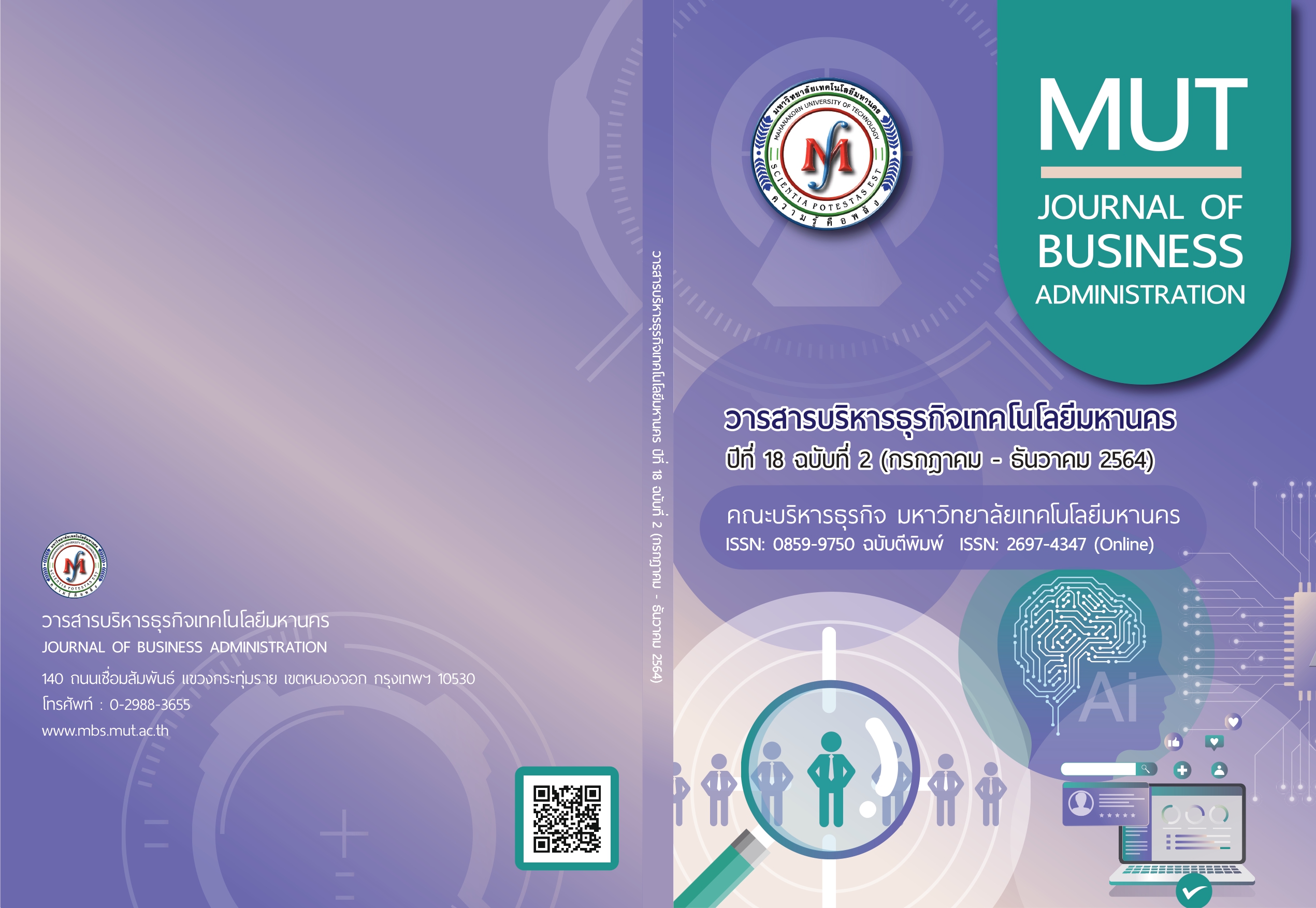Factors influencing the behavior of online food ordering via Grab Food of consumers in Khlong Yong Subdistrict, Phutthamonthon District, Nakhon Pathom Province
Keywords:
Service Marketing Mix, Brand Image, Online Food Ordering, Grab FoodAbstract
At present, the service business sector needs to drive service efficiency. The key factor is customer behavior data. Executives need to analyze strategies for improving products and services to satisfy customers’ needs and meet their needs continuously. The objectives of the present research were 1) to study the differences in demographic factors affecting the behavior of online food ordering via Grab Food among consumers in Khlong Yong, Phutthamonthon, Nakhon Pathom, and 2) to study the influence of factors on consumers' behavior of online food ordering via Grab Food. This study classified the population according to their characteristics such as sex, age, educational level, occupation and average monthly income. Quantitative research was used as a research protocol. The questionnaire was a tool for collecting data from 400 consumers who ordered food through the online application, Grab Food. Descriptive statistics and Structural Equation Model (SEM) were used for statistical analysis. The results showed that most of the respondents were female. Most of them were over 30 years old, had a bachelor's degree, were self-employed, earned over 15,000 baht monthly income of, and most were married/living together. The results showed that the service marketing mix had the greatest influence on brand image factors, followed by brand image factors affecting online food ordering behavior factors and service marketing mix factors influencing factors on online food ordering behavior, respectively. All factors were 0.5 statistically significant. Therefore, the results of this research enable the service sector to drive efficient service delivery in the present era and to continually improve products and services to meet customers’ satisfaction and demand
References
คำนาย อภิปรัชญาสกุล. 2558. พฤติกรรมผู้บริโภค (Consumer Behavior). กรุงเทพฯ: บริษัท โฟกัสมีเดีย แอนด์ พับลิซซิ่ง จำกัด.
พิมพุมผกา บุญธนาพีรัชต์. 2560. ปัจจัยส่วนประสมทางการตลาดที่มีผลต่อการตัดสินใจใช้บริการ Food Delivery ในเขตกรุงเทพมหานครและปริมณฑล. สารนิพนธ์ บธ.ม. กรุงเทพฯ: คณะพาณิชยศาสตร์และการบัญชี.: มหาวิทยาลัยธรรมศาสตร์.
พัชรวลัย ชัยวรรณเสถียร. 2563. การตัดสินใจใช้บริการแอปพลิเคชั่นฟู้ดแพนด้าของบุคลากรหน่วยงานราชการ ในอำเภอเมืองเชียงใหม่ ทัศนคติด้านส่วนประสมการตลาดบริการที่มีความสัมพันธ์กับพฤติกรรมการใช้บริการธุรกิจไลน์แมนของคนวัยทำงานในกรุงเทพมหานคร. วารสารบริหารธุรกิจและสังคมศาสตร์. ปีที่ 3 ฉบับที่ 1 มกราคม – เมษายน 2563.
เปรมกมล หงส์ยนต์. 2562. ปัจจัยที่มีอิทธิพลต่อการตัดสินใจซื้อสินค้าผ่านทางแอพพลิเคชั่นออนไลน์ (ลาซาด้า) ของผู้บริโภคยุคดิจิทัลในกรุงเทพมหานคร. กรุงเทพฯ: บัณฑิตวิทยาลัย มหาวิทยาลัยสยาม.
ศูนย์วิจัยกสิกรไทย. 2562. บทวิเคราะห์แนวโน้มธุรกิจ การแข่งขันของแอปพลิเคชั่นสั่งอาหาร ดันธุรกิจ ธุรกิจบริการจัดส่งอาหารเติบโตต่อเนื่อง คาดมีมูลค่าสูงถึง 33,000 – 35,000 ล้านบาท ในปี 2562 (กระแสทรรศน์ ฉบับที่ 2995). สืบค้นวันที่ 25 มกราคม 2564 จาก https://kasikornresearch.com/th/analysis/k-econ/business/Pages/z2995.aspx
สำนักงานพาณิชย์จังหวัดนครปฐม. 2562. รายงานประจำปี 2562. สืบค้นวันที่ 25 มกราคม 2564 จาก http://www.nakhonpathom.go.th/news_report/cate/23.
อลิศศอานันท์ เจริญพูล. 2561. กลยุทธ์ทางการตลาดที่มีอิทธิพลต่อกระบวนการตัดสินใจซื้อเครื่องสำอางผ่านระบบ mobile commerce. สารนิพนธ์ บธ.ม. (การตลาด).กรุงเทพฯ: บัณฑิตวิทยาลัย มหาวิทยาลัยศรีนครินทรวิโรฒ.
อาชิรญา บุญเพิ่ม. 2021. พฤติกรรมผู้บริโภคและกลยุทธ์ทางการตลาดของผลิตภัณฑ์ชาใน ประเทศไทย. สารนิพนธ์ บธ.ม. กรุงเทพฯ: บัณฑิตวิทยาลัย มหาวิทยาลัยมหิดล.
Grabfood. 2563. ข้อมูลบริษัท. สืบค้นวันที่ 30 มกราคม 2564 จาก https://assets.grab.com/wp-content/uploads/media/si/reports/Grab-ESG-Report-2020.pdf
Chrysochou, P. 2010. Food health branding: The role of marketing mix elements and public discourse in conveying a healthy brand image. Journal of Marketing Communications. Vol. 16. Issue. 2. 69 – 85.
Gilaninia, S., Taleghani, M., & Azizi, N. 2013. Marketing mix and consumer behavior. Kuwait Chapter of the Arabian Journal of Business and Management Review. Vol. 12. Issue. 2. 53 – 63.
Hair, J. F., Black, W. C., Babin, B. J., Anderson, R. E., & Tatham, R. 2006. Multivariate data analysis. Uppersaddle River.
Hanna, N., & Wozniak, R. 2001. Consumer behavior: An applied approach (Doctoral dissertation, Univerza v Mariboru, Ekonomsko-poslovna fakulteta).
Hien, N., Phuong, N., Tran, T., & Thang, L. 2020. The effect of country-of-origin image on purchase intention: The mediating role of brand image and brand evaluation. Management Science Letters. Vol. 10. Issue. 6. 1205 – 1212.
Hong, C., Choi, H. H., Choi, E. K. C., & Joung, H. W. D. 2021. Factors affecting customer intention to use online food delivery services before and during the COVID-19 pandemic. Journal of Hospitality and Tourism Management. Vol. 48. Issue. 3. 509 – 518.
Hutauruk, M. R., Ghozali, I., Aprianti, D. I., Reonald, N., & Mushofa, A. 2020. Marketing mix and customer satisfaction in its role toward customer loyalty through environmental accounting moderation. International Journal of Scientific and Technology Research. Vol. 9. Issue. 3. 996 – 1001.
Kotler, P., & Keller, K. 2016. Marketing Management 15th ed. New Jersey: Pearson Education.
Kim, J. J., Kim, I., & Hwang, J. 2021. A change of perceived innovativeness for contactless food delivery services using drones after the outbreak of COVID-19. International Journal of Hospitality Management. Vol. 4. Issue. 1. 102 – 158.
Lauterborn, B. 1990. New Marketing Litany: Four Ps Passé: C-Words Take Over. Advertising Age. Vol. 61. Issue. 4. 26 – 32.
Mazursky, D., & Jacoby, J. 1986. Exploring the development of store images. Journal of retailing. Vol. 89. Issue. 2. 46 – 61.
Nelson, P. 1970. Information and consumer behavior. Journal of political economy. Vol. 78. Issue. 2. 311 – 329.
Sawaftah, D., Calıcıoglu, C., & Awadallah, R. 2020. The relationship between viral marketing and consumer purchase intention, the moderator role of brand image and age: Evidence from smartphone users in North Cyprus. Management Science Letters. Vol. 10. Issue. 6. 1307 – 1320.
Schumacker, R. E., & Lomax, R. G. 2004. A beginner's guide to structural equation modeling. psychology press.
Zhang, Y. 2015. The impact of brand image on consumer behavior: A literature review. Open journal of business and management. Vol. 39. Issue. 2. 58 – 79.
Yamane, Taro. 1967. Statistics, An Introductory Analysis. 2nd ed. New York: Harper and Row.
Additional Files
Published
Issue
Section
License
ข้อความ ข้อคิดเห็น ข้อมูล เนื้อหา รูปภาพ แผนภูมิ แผนผัง เป็นต้น ที่ปรากฏและแสดงในบทความต่างๆ ในวารสารบริหารธุรกิจเทคโนโลยีมหานคร ถือเป็นความรับผิดชอบโดยตรงของผู้เขียนบทความนั้นๆ มิใช่เป็นความรับผิดชอบใดๆ ของวารสารบริหารธุรกิจเทคโนโลยีมหานคร และมหาวิทยาลัยเทคโนโลยีมหานคร
บทความที่ตีพิมพ์ในวารสารบริหารธุรกิจเทคโนโลยีมหานคร ถือเป็นลิขสิทธิ์เฉพาะของคณะบริหารธุรกิจ มหาวิทยาลัยเทคโนโลยีมหานคร หากบุคคลหรือหน่วยงานใดต้องการนำทั้งหมดหรือส่วนใดส่วนหนึ่งไปเผยแพร่ต่อหรือเพื่อกระทำการใดๆ จะต้องได้รับการอนุญาตเป็นลายลักษณ์อักษรจากคณะบริหารธุรกิจ มหาวิทยาลัยเทคโนโลยีมหานครก่อนเท่านั้น


